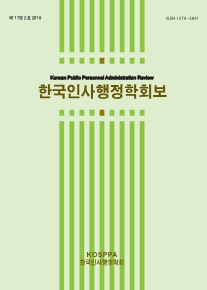본 연구의 목적은 공무원의 직무동기, 이직의도 및 조직문화의 세대별(20-30대 vs 40-50대) 차이, 직무동기가 이직의도에 미치는 영향, 직무동기와 이직의도 간의 관계에서 조직문화의 조절효과와 세대별 차이를 분석하고 이에 따른 이론적 함의를 제시하는 것이다. 이를 위해 2021년 우리나라 공무원 4,133명(중앙직 1,890명+지방직 2,243명)의 설문조사 자료를 분석하였다. 본 연구의 주요 결과를 요약하면 다음과 같다. 첫째, 공무원의 직무동기, 이직의도, 조직문화에 대한 인식은 세대별로 차이가 있었다. 구체적으로 공공봉사동기와 보수만족도는 20-30대가 40-50대보다 낮게 나타났고, 이직의도는 20-30대가 40-50대보다 높게 나타났고, 합리문화, 발전문화, 집단문화는 20-30대가 40-50대보다 낮은 반면, 위계문화는 오히려 높게 나타났다. 둘째, 공무원의 직무동기가 이직의도에 영향을 미치는 요인에는 공공봉사동기(b=-0.122), 보수만족도(b=-0.030), 기관유형(b=-0.091), 재직기간(b=-0.065), 보수만족도x연령집단(b=-0.115)으로 나타났다. 이는 공무원 중 공공봉사동기가 낮을수록, 보수만족도가 낮을수록, 중앙직일수록, 재직기간이 짧을수록, 보수만족도 수준이 낮은 20-30대 공무원일수록 이직의도가 높다는 것을 의미한다. 셋째, 공무원의 직무동기와 이직의도 간 관계에서 조절 역할을 하는 조직문화에는 위계문화와 집단문화가 있는 것으로 나타났다. 위계문화는 공공봉사동기와 이직의도 간 관계를 강화하는 조절 역할을 하고, 집단문화는 보수만족도와 이직의도 간 관계를 강화하는 조절역할을 하는 것으로 나타났다. 넷째, 공무원의 조직문화의 조절효과는 세대별로 차이가 있는 것으로 나타났으며, 20-30대의 경우 합리문화와 위계문화가 조절효과가 있는 반면, 40-50대의 경우는 집단문화와 위계문화가 조절 역할을 하였다. 마지막으로, 동일한 세대의 공무원 집단이라고 할지라도 집단내 조직문화에 대한 인식의 차이가 상당하였고, 이로 인해 조직문화의 조절효과도 다르게 나타났다.
The purpose of this study is to analyze whether public officials' job motivation, turnover intention, and organizational culture differ by generation (20-30s vs 40-50s), how public officials' job motivation affects turnover intention, whether organizational culture serves as a moderating variable in the relationship between job motivation and turnover intention of public officials and whether organizational culture differs by generation. Theoretical and policy implications are presented later. To this end, the survey data of 4,133 public officials in Korea in 2021 (1,890 central officials + 2,243 local officials) was analyzed. The main results of this study are summarized as follows. First, there were differences by generation in the perception of job motivation, turnover intention, and organizational culture of public officials. Specifically, public service motivation and remuneration satisfaction were lower among those in their 20s and 30s than those in their 40s and 50s, and turnover intention was higher among those in their 20s and 30s than those in their 40s and 50s. Rational culture, development culture, and collective culture were lower among those in their 20s and 30s than those in their 40s and 50s, but hierarchical culture was rather high. Second, the factors influencing job motivation of public officials on turnover intention include public service motivation (b=-0.122), remuneration satisfaction (b=-0.030), institution type (b=-0.091), and tenure (b=-). 0.065), remuneration satisfaction x age group (b = 0.115). This means that among public servants, the lower the motivation for public service, the lower the satisfaction with remuneration, the more the central position, the shorter the tenure, and the more 20s and 30s with a lower level of satisfaction with remuneration, the higher the turnover intention. Third, it was found that there are hierarchical culture and group culture in the organizational culture that plays a moderating role in the relationship between job motivation and turnover intention of public officials. Hierarchical culture played a moderating role in strengthening the relationship between public service motivation and turnover intention, and group culture played a moderating role in mitigating the relationship between remuneration satisfaction and turnover intention. Fourth, it was found that the moderating effect of the organizational culture of public officials differed by generation, and in the 20s and 30s, rational culture and hierarchical culture had a moderating effect, while in the 40s and 50s, group culture and hierarchical culture played a moderating role. Finally, even in the same generation of public officials, there was a significant difference in perception of organizational culture within the group, and the moderating effect of organizational culture was also different.
Ⅰ. 서 론
Ⅱ. 이론적 논의
Ⅲ. 조사설계와 분석방법
Ⅳ. 분석결과
Ⅴ. 결 론
참고문헌
(0)
(0)
